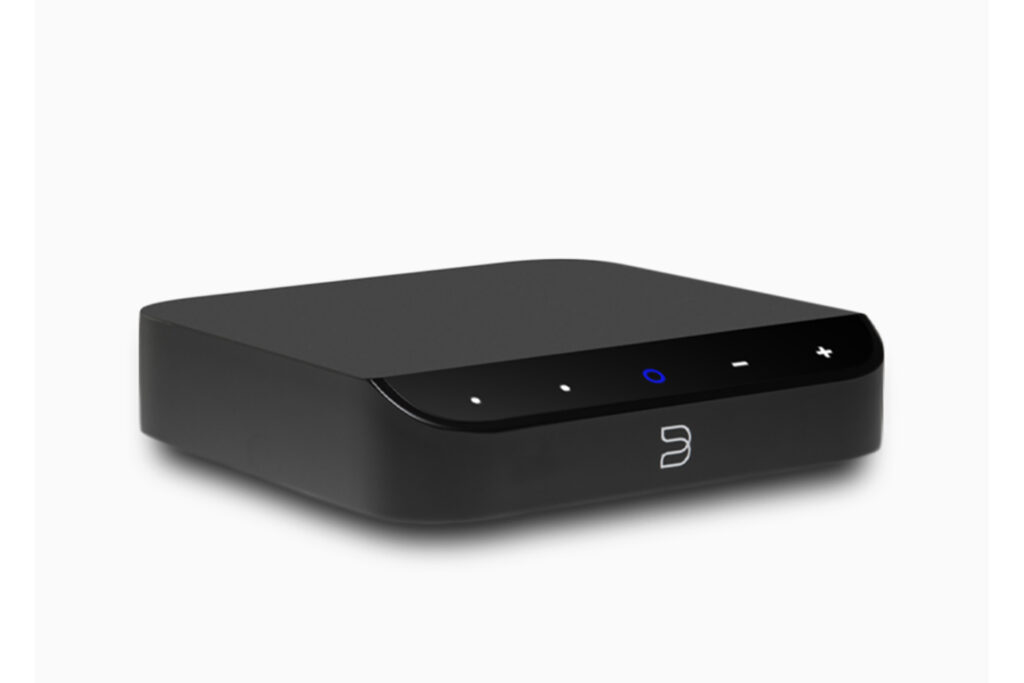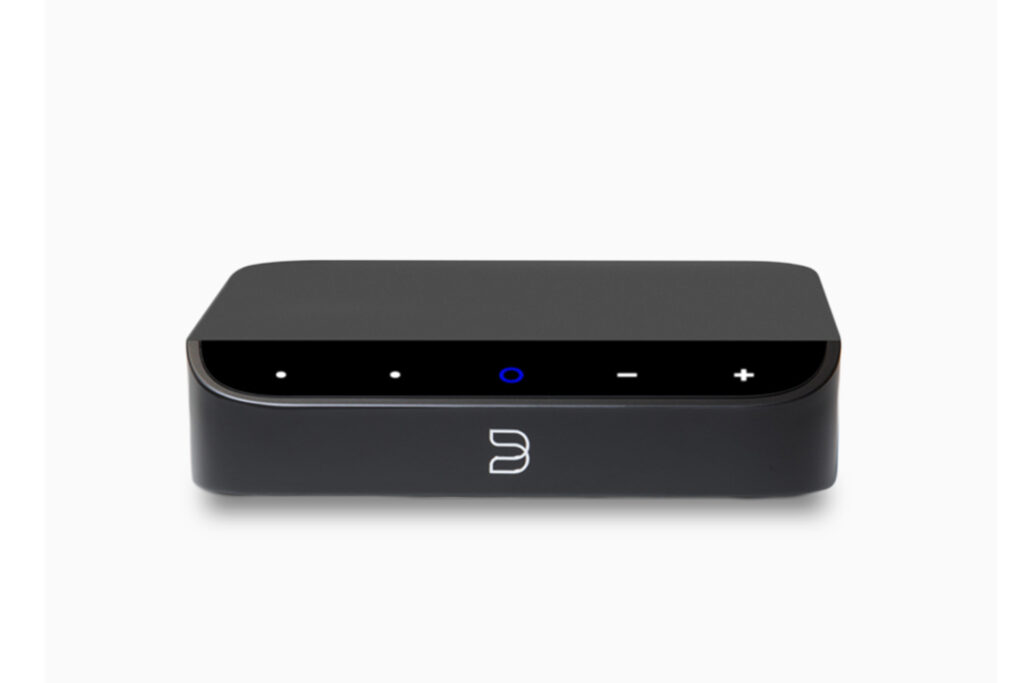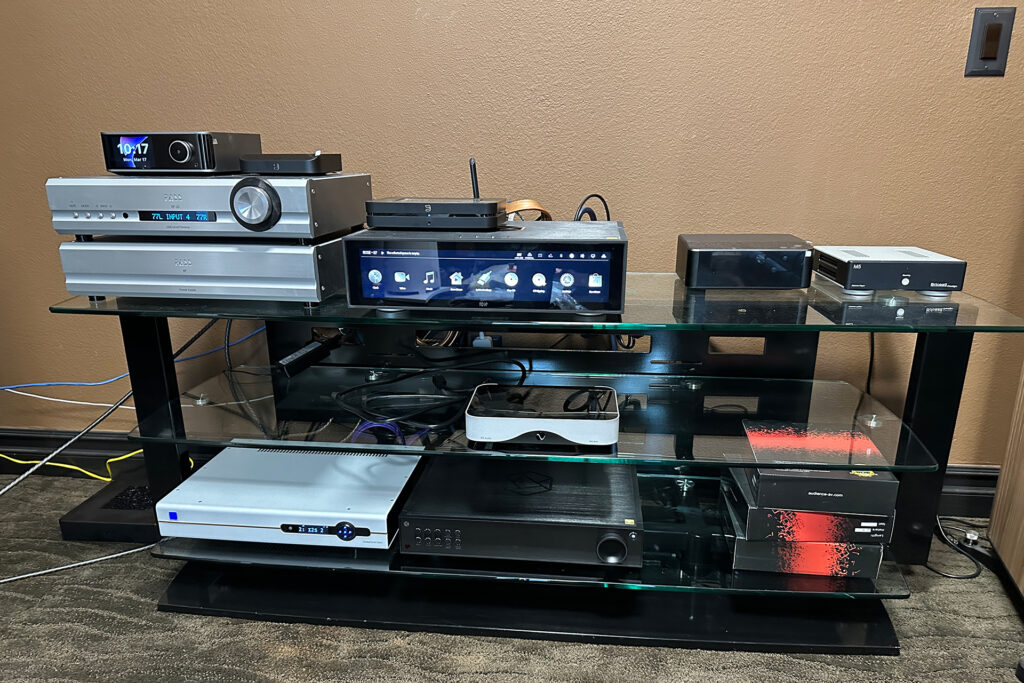Under its parent company Lenbrook, the Bluesound Node streamer/DAC product line has been a frequent favorite on the pages of Future Audiophile.com, with solid audio performance, an industry-leading operating system with BluOS, its companion music app, and sometimes competitive pricing. I say “sometimes,” because competition is fierce in this segment, with manufacturers quickly updating DAC chips to the latest and greatest, adding features, connectivity, and style at consistently lower prices. With that environment in mind, it is unsurprising that we are now into the fourth generation (2024) of the Bluesound’s Node product line. At the top sits the Node Icon, and in the middle is the recently reviewed Node 2024. Here, we will review the entry-level Bluesound Node Nano,retailing for $349 (buy at Crutchfield). It is a new concept for Bluesound to have a low-priced basic streamer/DAC, with limited features but the same robust BluOS operating system. Join me while I deeply examine its features, what has changed, and how it sounds.

What Makes the Bluesound Node Nano Music Streamer So Special?
- The Bluesound Node Nano is a new lower-priced model that offers basic connectivity, but with the significant Bluesound operating system: BluOS. It shares the same processing computer, an ARM Cortex A53 Quad Core – 1.8GHz per core, as do its two more affluent siblings.
- Speaking of BluOS, the Node Nano and all Bluesound Node streaming models benefit from this operating system and Bluesound app, which integrates over 23 streaming music services. It is the only operating system I know of that integrates Amazon Music (perhaps Sonos). Of course, the more established streaming service Spotify and audiophile favorites Tidal and Qobuz are also supported, to name just a few. Do you like the free or paid Pandora streaming service? The Node Nano with BluOS has you covered. While all streamer operating systems take a bit to get used to, the BluOS learning curve is better than most, has no glitches in my experience, and supports whole-house music with its ability to connect and control over 60 Bluesound-enabled streamers or components integrated with the BluOS module. Spotify Connect, TIDAL Connect, Apple Airplay 2, Alexa voice control, and Roon Ready certification are also supported.
- While all popular file types are supported, BluOS also continues to support MQA files, which is no surprise, since its parent company, Lenbrook, acquired MQA in 2023. While there was controversy over the benefits of MQA, it is clear Lenbrook thinks they can develop it further.
- As part of the fourth-generation update, all Bluesound Node streamers, including the Node Nano, include ESS Sabre’s latest DAC chip (for now), the ES 9039Q2M, which incorporates their latest Hyperstream IV Modulator. While I am not sure if DAC chasing has any merit, since integration of the DAC chip is also paramount, as is power supply and individual part selection around that DAC, it is somewhat satisfying that, at entry-level pricing, the Node Nano implements the latest DAC chip.
- New for the fourth-generation models, DSD 256 (up to) is supported natively. Today’s popular streaming services use the PCM codec, but who knows what the future holds? If you purchase music files and prefer (and can find) your favorite music in DSD, the Node Nano can support that natively.
- The Bluesound Node Nano has a high-quality matte black plastic case with an excellent feel. The unit is smaller and lighter than past models, measuring just under six inches square and about 1.5 inches high. It is just a bit larger than an Apple TV 4K streamer.However, it retains the classic Bluesound sensory control panel for direct local access to the player. Ideally, the user would engage the control app via their mobile device.
- The Bluesound Node Nano wired Ethernet input supports gigabit Internet speed, and WIFI 5 (802.11ac) and Bluetooth 5.2 AptX offer wireless connectivity.
- USB Audio 2.0 type A input allows easy connection of external storage. USB can be a bit noisy for an audiophile DAC, but for data transmission, USB is a pretty strong performer.
- Digital outputs include RCA Coax, optical Toslink, and USB Audio 2.0 type A. These digital outputs bypass the system’s internal DAC, allowing system expansion to external DACs when you think it is time to step up your game.
- The Node Nano uses RCA analog outputs, allowing mass compatibility. Engaging its variable line-level output enables the Node Nano to be used as a preamplifier, allowing direct connection to an amplifier. Of course, the output level can be fixed, allowing the Node Nano to be used more like a selectable source of your preamplifier.
Why Should You Care About the Bluesound Node Nano Streamer/DAC?
The Bluesound Node product line has been around for over 10 years. While the products have evolved over the years to align with the times, the Node Nano is the first Bluesound streamer/DAC at this retail price point, providing essential connectivity only and staying away from interesting features that are not needed. By doing so, consumers can have a state-of-the-art DAC chip and a refined operating system that supports high-resolution 24-bit, 192kHz speed, with significant streaming service integrations that can add over 60 Bluesound integrated components for whole-home audio, for $349. That is something to care about.

Some Things You Might Not Like About the Bluesound Node Nano …
- There is little to dislike if you consider the intended customer, their needs, and Nano’s competitive price point. Any omission of connectivity or features was intentionally done to target the intended end user. If you need more, move up in the product line.
- Again, by intent and name, the Node Nano is small, allowing easy integration. If you are looking for a showpiece and more of an anchor component, move up the product line or look elsewhere.
Listening to the Bluesound Node Nano Music Streamer …
My current reference system is a Pass Labs XP 22 preamplifier wired to a set of Pass Labs XA60.8high-current monoblock amplifiers. They operate in full Class-A mode up to 60 watts at eight ohms, doubling power at four ohms and again at two ohms. Estelon Aura floorstanding speakers would be the final stage of my system, creating a highly resolving platform. The Bluesound Node Nano is connected to my system through its RCA analog outputs to the Pass Labs XP 22 preamplifier. The system benefits from Wireworld Eclipse 8 speaker cables, interconnects, and Electra 7 power cables for the amplifiers.
One of my common audition tracks is “Fast Car” by Tracy Chapman, Qobuz FLAC 16/44.1, from her 1988 eponymous album. This track provides a sound recording with an engaging female voice that allows me to quickly ascertain audible nuance. With the Bluesound app fired up, performance was commendable. There was space off the dark backdrop, with excellent three-dimensionality of instrumentation and vocals within the broad soundstage. Truly impressive.
On hand was the WiiM Ultra, from a recent review (read that here). I like to compare streamers side by side when I can, which provides context for both you and me. With a streamer/DAC, the comparison is easy, since I can toggle between preamplifier inputs with the same song playing, which I did here. It was not hard to discern the difference, with the Node Nano reigning supreme. The WiiM sounded thin in comparison, with a nonexistent mid-bass and a leaner take on vocals. Cymbals had less clarity, with more smearing.
Let’s take this further with Roon (learn all about Roon here) and its ability to circumvent each streamer/DAC’s proprietary app and move it onto the Roon platform. While the WiiM Ultra and Node Nano improved with Roon’s management, the same characteristics prevailed, with the Node Nano still taking the title.
To try this with another track, I played The Lumineers’ “Ophelia,” Qobuz FLAC 16/44.1, from their 2016 Ophelia album. I returned to each streamer’s proprietary app, and it was easy to distinguish each player. The Node Nano had better imaging, mid-bass, smoother vocals, and a more convincing presentation. With The Lumineers still playing and now moving to Roon, the WiiM continued to trail the Node Nano, with less depth to the presentation and a lack of mid-bass presence.
Putting the WiiM aside, I moved to a third-generation Node that I keep on hand for comparison purposes like these. With the aforementioned tracks and the Bluesound app toggling between the Node Nano and third-generation Node through the preamplifier, the difference was less dramatic than with the WiiM Ultra. It was challenging to discern their differences, but I have to give it to the Nano again, with just a tad more clarity on the upper-end frequencies where cymbals play. Vocals were also more convincing with the Node Nano.
With both Bluesound streamers, I moved the contest to Roon, again on the same two tracks. The difference was close, but the Nano had more projection into my room and a slightly more convincing presentation. To sum this up, the Bluesound Node Nano is the winner on both proprietary music apps and Roon, with Roon consistently allowing each streamer to demonstrate its best.
One last thing: I tested the Bluesound Node Nano’s variable outputs (volume control) to see if this unit could realistically be connected directly to an amplifier. It worked very well. It was not as good as running the Nano through my preamplifier, but still competitive. I have experienced high-performing streamer/DACs that fall short in this area. It is apparent that the engineers at Bluesound deliberately focused on this feature. The volume performance tells me they implemented the DAC chip with care because, from what I understand, that is where the volume control resides.
Will the Bluesound Node Nano Keep its Value?
While limited in its connectivity options, the Bluesound Node Nano has a solid BluOS platform that is continually being improved and updated; hence, the Nano is updated along with it, keeping the streamer modernized. Additionally, the newer Sabre DAC will keep it relevant for a few years, if not many years, into the future. Based on my listening comparison, the implementation of the DAC was well done, giving the Nano even more leverage. At such a low price, depreciation is limited, especially considering its intended use. Better than average depreciation is expected.

What Is the Competition for the Bluesound Node Nano?
From a price perspective, the WiiM Ultra (buy at Crutchfield), which I compared side by side here, is a tough competitor to the Bluesound Node Nano, even though I preferred the sound performance of the Nano. At $299, the WiiM Ultra is stacked with more connectivity, functionality, options, and a color touchscreen, albeit a small one. With a built-in homegrown simplistic room correction system and EQ, it goes far beyond the Node Nano. However, it lacks the BluOS ecosystem and, as I demonstrated, the Nano audibly outperforms. However, depending on your needs, your priorities may differ when determining which product is right for you. For example, if you only want background music, prefer HDMI connectivity to connect to your television, and are hard-stopped at $300, the WiiM Ultra may be the better route.
Other Bluesound models are a consideration. As I explained, the third-generation 2021 Node has similar audio performance and more connectivity. It is still available on their website for the same price as a Nano, $349, a marked-down bargain price while it lasts.
If you are willing to add $300 to your purchase, the fourth-generation (2024) Bluesound Node (buy at Crutchfield) is a consideration. It has more connectivity than the Node Nano and includes a headphone output, as well as Dirac Live, meaning the user can purchase a license to add Dirac room correction. I have not experienced the new Node (middle model), but it is cut from the same cloth as the Nano, and it will be equally as astute as the Nano. If the budget allows, the middle Node model will take you further.
The next streamer/DAC review I have in the queue, which will immediately follow this one, is the Bluesound Node Icon (buy at Crutchfield), the top dog in their lineup. I have the Bluesound Icon connected to my system as I write this review, and I have compared it to the Node Nano. However, the Icon’s performance outcome is a discussion for that review. Stay tuned!

Final Thoughts On The Bluesound Node Nano Music Streamer …
The Bluesound Node Nano is a new concept for Lenbrook: entry-level price and entry-level features: all you need for a simple yet sophisticated implementation of high-tech streaming into your home, with a stellar ecosystem to grow into. If you’re seeking an affordable way to enhance your audio system with robust streaming, the Bluesound Node Nano is an excellent option. While it lacks multiple connectivity options, you may not need them. As you are likely aware, NAD and PSB are under the Lenbrook umbrella and include the BluOS module in those products, which rounds out the technological ecosystem. For example, if you had a NAD AV receiver, preamp processor, high-end NAD Master Series streamer/DAC, and a set of wireless PSB speakers, they would utilize the same Bluesound APP for music streaming and navigating all your connected BluOS-enabled devices.
Bottom line: I am impressed with the performance of the Bluesound Node Nano and believe it is an excellent option for consumers looking for a simple path to add high-performance streaming to their homes on a budget.
BlueSound Node Nano FAQ
Is the BlueSound Node Nano an amplifier?
No. The BlueSound Node is a low-cost, yet very capable music streamer that is capable of Sonos-like access to mainstream streaming services that Roon and other more audiophile music streaming services can not deliver. The BlueSound NODE can connect to an AV receiver, integrated amp or DAC depending on your system configuration.
Do I need a DAC with the BlueSound Node Nano?
You don’t NEED a DAC per se since the BlueSound Node has a suitable DAC inside of the unit. Many audiophile will want to connect their Node to a more fancy or high performance DAC (often with a better power supply, newer chipsets or better jitter mitigation) which can be in the form of a stand-alone DAC, a DAC inside of your stereo preamp or Integrated Amp or even connecting a BlueSound Node to an AV receiver.
Is BlueSound better than Sonos?
If you ask a custom installer, they will tell you BlueSound is better as Sonos made no friends with their just awful software roll-out. They basically lost the custom installation (CI) market and “bricked” a lot of products.
Sonos’ user interface is excellent. They have excellent access to the more mainstream streaming platforms but BlueSound is much more tuned in to the needs of today’s audiophile. If you are an audiophile and/or building an audiophile system – BlueSound is a great option. They have the same connectivity (similar) as Sonos and can be used wirelessly all over your home which is appealing for both platforms. BlueSound is also built into products like NAD, PSB and beyond.
How to connect a BlueSound Node Nano?
The way that we recommend is to connect a BlueSound NODE Nano via digital output into your DAC. That DAC might be included in your stereo preamp, as part of a stand-alone digital to analog converter or as part of an integrated amp and/or AV receiver.
By no means MUST you connect a BlueSound Node Nano via a digital connection (USB is not our favorite). We would wish for an I2S (like HDMI) or an AES/EBU connection but no current BlueSound Node has those digital outputs. Our recommendation would be to use COAX for digital and RCA for analog connections thus using the internal DAC inside of the BlueSound Node.
What type of DAC Chips does the BlueSound Node Nano Use?
ES 9039Q2M from ESS – makers of the Sabre DACs and used in many, far more high end external DACs ranging from CHI-FI (think: under $1,000 DACs) to much more expensive audiophile options.
This is a very good chipset and a very capable DAC overall that is included inside of a relatively low cost music streamer.




Bluesound Nano vs WiiM Ultra, Sabre vs AKM? It would have been more instructive to compare the Nano vs WiiM Mini with outboard good quality Sabre 9039Q2M based DAC?
Nice review similar to others on YouTube, but I’d like to know how it performed feeding an external DAC via USB – an asynchronous connection – so the clock in the external DAC could do the “driving”? And comparing the similarly priced WiiM Ultra feeding that same external DAC, also via USB. And you talked about the “non-existent or thin” mid-bass of the Ultra, but did you try adjusting that in the provided digital EQ or parametric EQ?
It is nice to have options, especially for the entry level for those “streaming curious” and products like these are far and above similarly priced Raspberry Pi devices of just a few years ago that we were all excited about.
Thanks for the thorough and insightful review. Based on your observations, and other reviews, I purchased the Nano. It is as advertised, a no frills streamer/dac with audiophile sound quality. Currently use with Vandersteen VLR-CT speakers, Belles Aria Two integrated amplifier and Audioquest cables and power conditioning. Considering an outboard power supply to further refine the sound. Well done and many thanks!
Gary,
Thanks for the kind words and smart move on the Nano. What a value.
I LOVE the UI on Bluesound. Does it have some issues? Yes but so do $20,000 units. Arguably MORE CRITICAL issues.
My Bluesound Nano runs seamlessly on Roon platform. Have had zero issues with dropouts or integration. Hard to find a sub $1000 unit with this type of musicality and ease of use. Purchased a SBooster Eco Mk II outboard linear power supply which took the sound to an even higher level. Keep up the great work on your site!